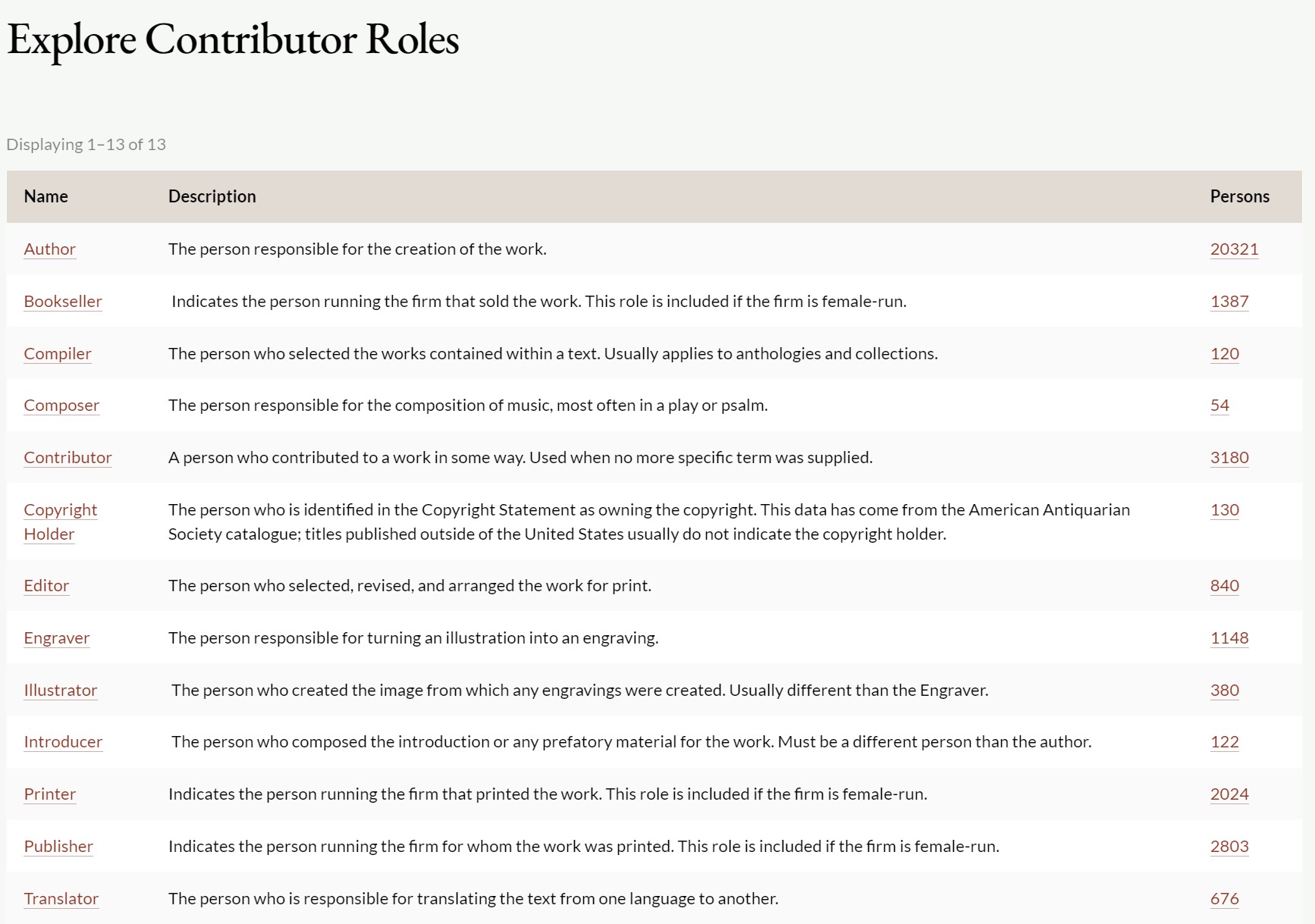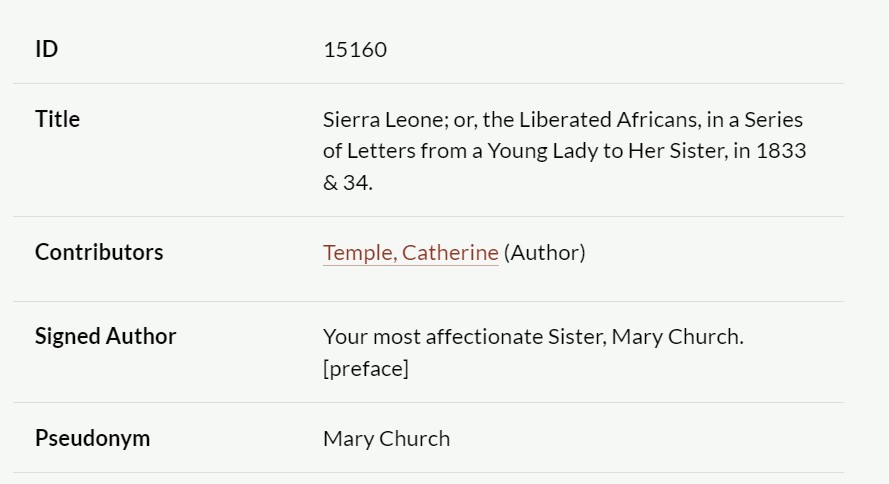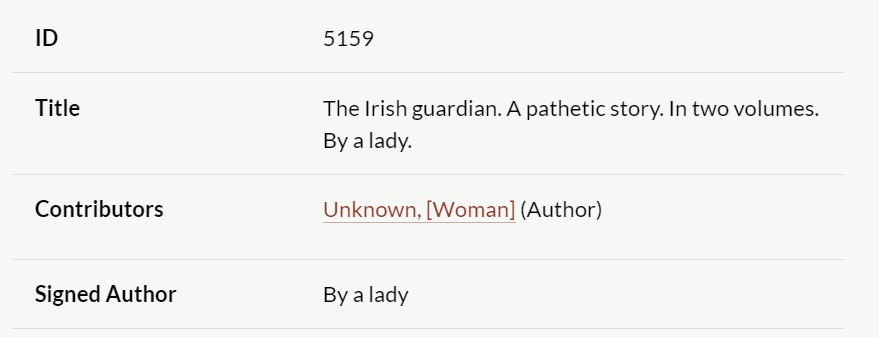This post is part of our By Our Books: Bibliography in the WPHP Spotlight Series, which will run through July 2023. This series attends to the bibliographical fields of the WPHP title records, tracing the history of our thinking about our descriptive practices and how they are informed by the sources available to us and by our feminist ambition to recognize and reconstruct women’s labour in print, broadly conceived.
Authored by: Amanda Law
Edited by: Michelle Levy, Kate Moffatt, and Kandice Sharren
Submitted on: 07/06/2023
Citation: Law, Amanda. "(Contributor) Role Call." The Women's Print History Project, 6 July, 2023, https://womensprinthistoryproject.com/blog/post/119.

Figure 1. The thirteen Contributor Roles included in the WPHP.
The Contributors field of WPHP Title records includes the names of the author(s) of the title, and, where applicable, editors, engravers, illustrators, authors of introductory material, translators, compilers, composers, and copyright holders (see Contributor Roles for descriptions of each of these roles). In addition, women involved in the publication, printing, and/or sale of the title are listed as Contributors. While the DublinCore Metadata Initiative (DCMI) defines “Contributor” as “[a]n entity responsible for making contributions to the resource,” including organizations, our data model only lists individual persons as Contributors, with each name in the field linking to a separate Persons record. The DCMI also distinguishes between “Creator” and “Contributor,” establishing a hierarchy between authorship and other kinds of labour which the WPHP does not.
We source Contributor data from signatures on the title page or in the paratexts, but when authors use Pseudonyms (see Julianna Wagar's spotlight) or attributions that do not include a name (see Kate Ozment's spotlight on Signed Author), more extensive research is required to identify the author. Sources such as the American Antiquarian Society or British Travel Writing: Women's Travel Writing, 1780–1840 often note when a pseudonym is in use and attribute the title to the correct author. For example, title 15160, Sierra Leone; or, the Liberated Africans, is signed “your most affectionate Sister, Mary Church” at the end of the preface; we know Mary Church is a pseudonym for Catherine Temple, who is attached as the Contributor, because British Travel Writing has included this information in their notes. In other cases, we are able to recognize well-known pseudonyms or trace authorship through other titles referenced in the Signed Author field. If a title is unsigned or anonymous, but the author is known from other sources, we add that Person as a Contributor.

Figure 2. Title ID 15160 Contributors, Signed Author, and Pseudonym.
If we are unable to identify the author of the title, we attach the Unknown Person record in the Contributors field, or, if gender is known, either Unknown, [Man] or Unknown, [Woman]. The Unknown, [Woman] tag is particularly important to us as it allows us to track a woman’s involvement in the production of the title even if her identity is uncertain. We see this Contributor most often attached to titles signed by “a lady,” such as title 5159, The Irish Guardian, or other similar attributions. The WPHP currently contains 490 title records where Unknown, [Woman] is a Contributor. Of course, most of these titles were contributed to by different women, but we have no way of knowing how many. One other point to bear in mind: we typically take title pages and relevant paratexts at face value. If a title page states that the title was written “by a lady,” we accept the attribution without further evidence. It may be that a small number of these titles were in fact written by men, and if this kind of misidentification is known, we correct for it. We are, however, chiefly interested in how books were presented to the public, and this is our rationale for assigning gender based on title page and paratexual self-identifications.

Figure 3. Title ID 5159 signed “By a lady” with Unknown, [Woman] as the Contributor.
To highlight the involvement of women in the title’s production, we include women publishers, printers, and booksellers as Contributors. In addition to attaching them as Firms to the title record, we create separate Persons records for these women involved in firms and attach them as Contributors. The WPHP holds 1632 titles where women are attached to Contributors as publishers, 706 as printers, and 679 as booksellers.
Including a Contributors field allows us to emphasize the personhood of women involved in print during this period. Authorship attribution can often be vague, as we can see from almost seven hundred titles in our database signed “by a lady,” and is further complicated by pseudonyms and fully anonymous authorship. When it comes to the book trades, women are often hidden in the imprints of husbands or fathers, or through the use of first initials that do not signal their identities and offer only indeterminate gender identifications. By attaching Contributors, we are able to dig beneath these layers of obscuration to highlight the women behind these titles, and where the woman is unknown, we are at least able to capture the scope of women’s labour.
WPHP Records Referenced
Contributor Roles (field)
Persons (field)
"What's in a Name?: Pseudonymous Texts in the WPHP" (spotlight by Julianna Wagar)
"The Language of Authorship" (spotlight by Kate Ozment)
American Antiquarian Society (source)
British Travel Writing: Women's Travel Writing, 1780–1840 (source)
Unknown (person)
Unknown, [Man] (person)
Unknown, [Woman] (person)
The Irish guardian. A pathetic story. In two volumes. By a lady. (title)
Firms (field)
Works Cited
“Contributor.” DublinCore Metadata Initiative, 20 Jan. 2020, www.dublincore.org/specifications/dublin-core/dcmi-terms/terms/contributor/.